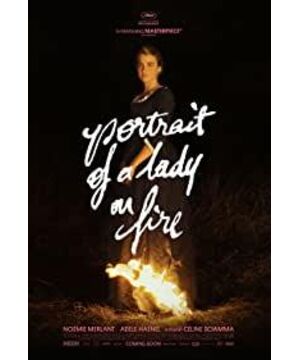Yesterday, I heard a male director on a film critic radio talk about burning pictures of women. One of the details is that at the climax of the film, Héloïse's skirt caught fire and then fell, and then the camera moved to the customs border. The two of them pulled their hands and said that this should be here. Pull over and cut directly to the kiss, and the plot in the movie is that after pulling H and walking to the stone, the painter goes over and kisses again. He said that this scene is a bit redundant.
If this is the case, this movie will not be restrained and the rhythm of the romantic movies we often watch is no different. When I first saw it, I was really confused. The scene transition is very sharp and sharp, but then I think this is the director's intention. This scene is like the restraint and pain of being so deeply in love, and then ruthlessly pinching off thoughts, which jumps out of the usual rhythm of most romance films.
It's a little bit finer at the bonfire party burning the skirt where the tones are very strong warm tones the whole atmosphere climaxes with the singing when H fell but couldn't shoot the painter's behavior after picking up her in the scene at that time maybe after picking up Two people can't be on their own. Of course, the environment of the current bonfire party does not allow too many people. Even if the protagonists are excited, they can only hold back, so they immediately switched the camera and held hands at the beach (corresponding to support) because they can only be in This was done secretly in an environment with no one on the beach, so the painter helped up the fire in another background, H who fell down and continued the story that might happen after helping her up
Here, the camera suddenly switched to the seaside image, and the cold tone of singing stopped. The voice of the sea also changed the audience from excitement to calm. The sensory gap completed a perfect emotional mobilization. The emotional restraint of the protagonist was also passed on to the audience. Emotions have also become patient and restrained, even a little sad
Then H walked to the stone side silently first, and the painter followed. I felt that the two were confused and hesitant, and their emotions were difficult to suppress, and they were looking for a safer and more private place. Even H was a little impatient when waiting for the painter to follow. Only after the first kiss and kiss, H ran away alone. At this moment, she is still confused. This kind of feeling of wanting and welcoming and full of taboos that can be experienced is quite complicated and hesitant. This is female. Emotional characteristics are not as decisive and bold as men's treatment of emotions. Due to the particularity of the age, they cannot express their emotions in broad daylight.
In the end, the painter went back to the side until it was dark, and then slowly turned to the side of the stove. The picture gradually became warm again. At this time, the two people's hearts and bodies were really close to the fire. There was no bonfire, not dry wood, and the fire seemed more ambiguous.
This series of shots does not have any excess, but just controls the rhythm just right, showing a very delicate, gentle and patient emotion that is gradually spreading, which is quite in line with the delicate and complex emotional characteristics of women, so this is the "female gaze" that has been mentioned all the time.
Conclusion: The [subjective] comments on this film from a male perspective have no reference value
——————Another topic——————
Some time ago, when I was learning about wine, I saw a label with a woman's head on the bottle cap of French wine. It said that it was a French tax certification mark. The woman on it is one of the symbols of the French Republic. Movie I'm too sensitive about this name so I went to know about this Marianne
As an anthropomorphic image, Marianne is a symbol of freedom, reason and common people in France. There is a saying that the reason why the image of France was represented by women at that time was to destroy the old system dominated by men. Vice "From. Oil guides people. The woman holding the red, white, and blue tricolor flag high (there should have been an illustration in high school history books)
So I arbitrarily extended this Marianne to Burning Female Figure. If I use this name as the name of the protagonist painter, it means that this concept should also be used in the film to break the aesthetic standards of the male-dominated art tradition and even the system uses her to wake everyone up. The female-conscious painter Marianne didn't just stare and interpret Heloise in her own way at first, but also male-centered viewing of traditional portrait repainting. When women really become active observers, they become a role against the traditional "male gaze". It shows the awakening of women's and fans' anti-consciousness. At the same time, the name is also a symbol of equality and common people. This film also shows the true portrayal of the fate of common women. For example, the maid who is pregnant and unmarried uses methods such as running wildly, drinking medicine and giving birth to depict many common women at night. The scene of holding hands and singing in front of the bonfire shows the close connection among women who conspire together. The lady, the maid, and the painter sit together to play cards and read stories. It also reflects the equal relationship across identities.
Going back to the name Marianne, no matter whether it has such a meaning or not, the meaning of burning female pictures in my mind is still a revolution in the film industry. Further, the impact of this film on me is something I have never encountered before. The concept of "Female gaze" is more vivid and specific, allowing women to consciously gradually break away from the concept of male gaze. They are no longer the "behold". Women can also change the way and angle of viewing things and people to conduct subjective inspections (I define its greatness by myself )
In addition, Ms. Adele Haenel, the star of Burning Girl, protested at the Caesars Awards Ceremony for a director who had committed sexual assault and left the audience angrily. To a certain extent, it also promoted the change of Caesar and even the French film industry. The scenes are very "burning women".
I always love burning female figure threesome
View more about Portrait of a Lady on Fire reviews











